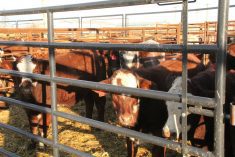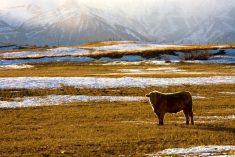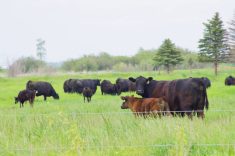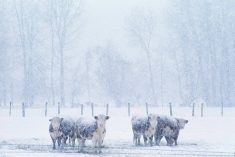Despite falling prices on U.S. cattle futures markets, bids remained steady at auction sites in Manitoba during the week ending April 29.
More than 7,200 cattle went through the rings during the week, down from 8,600 the week earlier, as feeder numbers start to settle down before the summer. While prices have remained steady for the most part, those for feeder heifers have slightly declined. More butcher cattle were also sold at auction compared to the previous week.
“The grass market stayed very strong,” Robin Hill, manager of Heartland Livestock Services at Virden, said. “There aren’t a whole bunch of heavy cattle around this time of year, but (there are) still lots of orders for them. In the butcher trade, (bids for) cows and bulls have gone up over the last month.”
Read Also

Polycrops a winning practice for Manitoba ranch
Using diverse, multispecies forage crop mixtures to feed their beef herd has dramatically improved cattle health, rancher says
At the Chicago Mercantile Exchange (CME), the June live cattle contract was trading at US$116 per hundredweight on April 30, a US$10 decline from three weeks earlier and its lowest price since January. Meanwhile, the May feeder cattle contract’s value has dropped by US$16 since the end of March and was trading at US$135.925/cwt, its lowest point since the end of October 2020. The Canadian dollar has also risen to more than 81 U.S. cents, its highest point in three years.
Most cattle are staying in Western Canada with a few more going to Eastern Canada and the U.S., according to Hill. However, dry conditions are forcing some producers to sell grass cattle earlier than usual, and Hill predicts the supply won’t meet demand pretty soon.
“I think the supply is going to start drying up. It’s going to be hard to find some classes of cattle, especially (those of) quality,” he said. “I think you’re going to see probably more erratic pricing. The good ones will (sell just) as strong, but we’ll see bigger discounts on some of the lighter cattle as the summer goes on.”
COVID-19 vaccinations began for workers at two beef-packing plants in Alberta — the Cargill plant at High River and the JBS plant at Brooks — on April 29.
Last spring, nearly half the workers at the Cargill plant and 650 workers at the JBS Canada plant tested positive for the virus with the former being shut down for two weeks. The two plants combined process almost 70 per cent of Canada’s beef.
Earlier in the week, Alberta Health Minister Tyler Shandro announced all meat-packing employees in the province would become eligible to receive COVID-19 vaccines, totalling more than 15,000 workers at 136 federal and provincial plants.



















